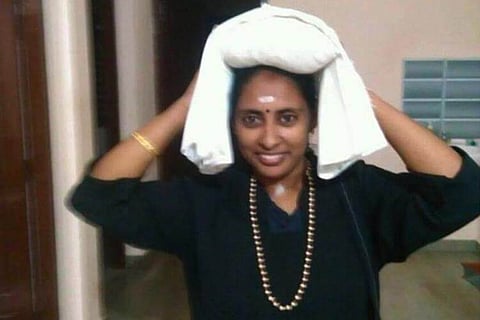
- Home
- Live Blog
- Breaking News
- Top Headlines
- Cities
- NE News
- Sentinel Media
- Sports
- Education
- Jobs

The issue which has been a subject of real tussle took much toll after the Supreme Court, on September 28, in a strongly-worded judgment, ruled that women of all ages must be allowed into Kerala’s Sabarimala temple ending a ban that prevented women and girls between 10 and 50 years from entering the shrine. However, the women who were hoping to make history by entering the temple gates had to face a setback when the chief Priest of the temple and a section of public protested against the order of the Supreme Court and prevented the women from entering the temple. Meanwhile, a petition is being filed in the Supreme Court by 19 petitions seeking a review of its order on Sabarimala. The hearing for the same to come up on 13th of November.
Since the 17th of this month after the temple opened its gate for its devotees, at least 13 women have attempted the trek to the hilltop shrine starting at the Nilakkal base camp, but none of these women could set their foot inside the temple. Some of these women were threatened and forced down the hills, while the other women voluntarily canceled the track in order to avoid the wrath of the agitated protester.
Libi C S was among the first women to try to enter the Sabarimala temple on the day that its gates were opened. Libi in one of her Facebook post had said that she tried to visit the Ayyappa deity, but protesters blocked her at a bus stand in Pathanamthitta, 65 km from the temple.
Madhavi, another gutsy woman from Andhra Pradesh in her 40s, tried to climb the Sabarimala hills to reach the Lord Ayyappa temple but was forced to return to Pamba, menaced by agitated male devotees. Madhavi’s decision to make the trek to the temple along with her family, saw her in deep water even though she was surrounded by the police on her way to the temple which forced her to abandon her plans.
The situation in the Sabarimala temple complex continued to remain tensed over the entire issue since the gates had been opened for devotees on 17th of this month last. Last Friday, too the situation grew tensed in the temple complex, when Delhi-based Suhasini Raj, along with her colleague, a foreign national, tried to enter the temple a day later the gates of the shrine was opened. They managed to go past the Pamba gateway, just before the climb to the hilltop shrine but was stopped midway by angry protesters who formed a human wall before her
Describing the incident, she was quoted as saying, “I had reached half way and then the protests grew stronger. I was hit by a stone and then we decided to return. The police had provided us with all the security.”
Dressed in riot gear and a yellow helmet Kavitha Jakkal, another Hyderabad based reporter, reached the Valiya Nadappandhal, the queue complex located a few meters away from the holy 'pathinettam padi' (the 18 sacred steps), leading to the sanctum sanctorum. Jakkal along activist Rehana Fatima would have been the first from the menstruating age group to visit the Lord Ayyappa temple and have made history had there been no angry protests by devotees, including senior citizens.
The Muslim community expelled Fatima from their community after her attempt to enter the shrine. Unidentified miscreants vandalised Fatima’s house Unidentified miscreants also vandalised Fatima’s house while she was away trying to climb the holy hills on Friday The police in Pathanamthitta too registered a case against the activist for hurting religious sentiments of the people.
Agitating Protesters in Sabarimala turned away other women Mary Sweety, 46, from Kazhakoottam near Thiruvananthapuram, minutes after Rehana and Kavitha beginning their trek back. “I go to church, mosques, and temples. And I want to see Lord Ayyappa,” Mary, told reporters. Police, however, escorted her to the control room where they reportedly told her they couldn’t provide protection for her trek up to the temple.
This is not the first incident of its kind. Two years back, women activist Trupti Desai of Maharastra had hit the headlines for making history by breaking a six-decade-old tradition and enter the sanctum of the Shani Shingnapur temple. A year Later Trupti was made the head of the Trust, that runs the temple. Though these incidents have been able to get the media hype yet there are many such religious places in India where Women devotees are still not allowed inside the religious premises. The sacred seat of Vashnavite culture, The Kirtan Ghar in Assam’s Barpeta too forbids women devotees from entering inside.
Like two sides of all matter if there is age-old religious beliefs and tradition on one hand, there are also liberating beliefs of a section of women who considers that when mensuration period of female Goddess is considered as sacred, then there should be no reason why women in the menstruating age group should be prohibited from worshipping. In Kamkhya temple too temple doors remain closed for devotees on the special occasion of Ambhubachi ( where Goddess Kamkhya is believed to undergo her mensuration cycle), as during these days it is considered to be most auspicious.
It may be mentioned here that as the stand-off over the entry of women of menstrual age into the famous hill shrine continued for the ninth day today, The doors of the shrine will open next on November 17 for the three-month-long Mandalam Makaravilakku celebrations when lakhs of devotees from the country and abroad visit the place every year.